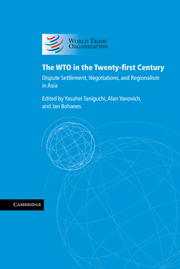Book contents
- Frontmatter
- Contents
- Notes on contributors
- Acknowledgements
- Table of dispute settlement cases and reports
- List of abbreviations
- Introduction
- PART I The WTO at Ten
- PART II Accomplishments and Future Prospects of the WTO Dispute Settlement System
- PART III Asian Perspectives on WTO Dispute Settlement
- PART IV The Doha Development Agenda and Beyond
- PART V Asian Regional Integration and the Multilateral Trading System
- 22 The adoption of the ‘Best Practices’ for regional and free trade agreements in APEC: a road towards more WTO-consistent regional trade agreements?
- 23 Trade remedy systems for East Asian free trade agreements
- 24 Free trade agreements in Asia and some common legal problems
- 25 Dispute settlement under free trade agreements: its interaction and relationship with WTO dispute settlement procedures
- 26 Regionalism under the WTO and the prospect of an East Asian free trade area
- Index
24 - Free trade agreements in Asia and some common legal problems
from PART V - Asian Regional Integration and the Multilateral Trading System
Published online by Cambridge University Press: 05 March 2012
- Frontmatter
- Contents
- Notes on contributors
- Acknowledgements
- Table of dispute settlement cases and reports
- List of abbreviations
- Introduction
- PART I The WTO at Ten
- PART II Accomplishments and Future Prospects of the WTO Dispute Settlement System
- PART III Asian Perspectives on WTO Dispute Settlement
- PART IV The Doha Development Agenda and Beyond
- PART V Asian Regional Integration and the Multilateral Trading System
- 22 The adoption of the ‘Best Practices’ for regional and free trade agreements in APEC: a road towards more WTO-consistent regional trade agreements?
- 23 Trade remedy systems for East Asian free trade agreements
- 24 Free trade agreements in Asia and some common legal problems
- 25 Dispute settlement under free trade agreements: its interaction and relationship with WTO dispute settlement procedures
- 26 Regionalism under the WTO and the prospect of an East Asian free trade area
- Index
Summary
The Asian scene
The number of free trade agreements (FTAs) notified to the General Agreement on Tariffs and Trade/World Trade Organization (GATT/WTO) had grown to 285 as of February 2004. By 2005, the number of free trade agreements (FTAs) notified to the General Agreement on Tariffs and Trade/World Trade Organization (GATT/WTO) exceeded 300. East and Southeast Asia have been the most active in the last half decade or so, with individual countries like Singapore and Thailand being the most active in Southeast Asia and Japan being the most active in East Asia. On the East Asian front, China has also concluded its two Closer Economic Partnership Agreements with Hong Kong and Macao in June and October 2003, respectively, as well as the goods agreement with the Association of Southeast Asian Nations (ASEAN) in November 2004. Japan, in addition to its FTAs with Singapore, the Philippines, and Mexico, has further ongoing negotiations with Korea, Malaysia, Thailand and also ASEAN. Korea has, in turn, concluded its FTA with Chile in 2003, and is now negotiating with the European Free Trade Association (EFTA) while Taiwan had earlier concluded an FTA with Panama. ASEAN as a whole has also been pursuing FTAs,1 particularly in East and South Asia and with the Closer Economic Relations (CER) nations of Australia and New Zealand; all this is in addition to the ASEAN Free Trade Area (AFTA) itself. Such activity in Southeast Asia is not, however, confined to intra-regional or intra-sub-regional trade.
- Type
- Chapter
- Information
- The WTO in the Twenty-first CenturyDispute Settlement, Negotiations, and Regionalism in Asia, pp. 434 - 456Publisher: Cambridge University PressPrint publication year: 2007
- 1
- Cited by

